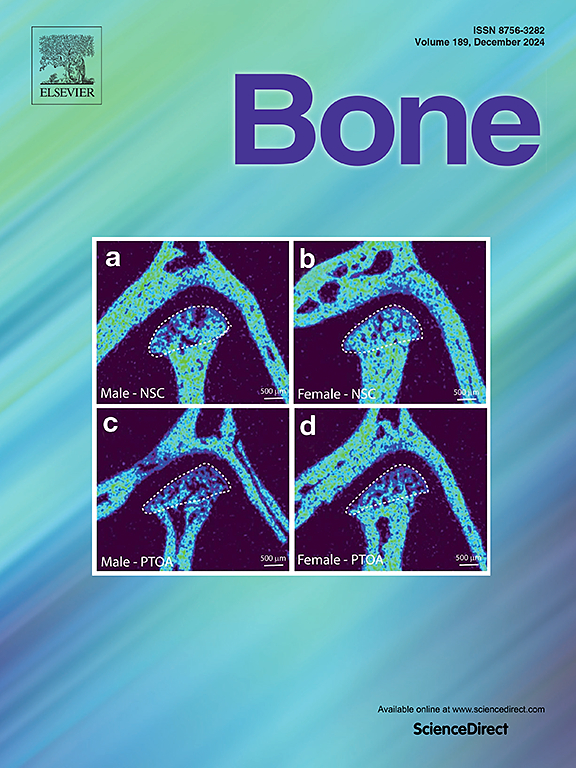基于hr - pqct的光滑六面体网格均匀化有限元模型。
IF 3.5
2区 医学
Q2 ENDOCRINOLOGY & METABOLISM
引用次数: 0
摘要
非线性均质有限元(hFE)模型可以通过在体HR-pQCT图像准确预测桡骨和胫骨超远端截面的刚度和强度。最近的研究结果表明,这些远端截面的刚度预测良好,但重现实验应变局部化的能力有限。基于体素的网格的粗糙性减少了计算工作量,但代价是大大简化了皮层的底层几何结构、材料属性的梯度以及由此产生的应变分布。为了克服这些限制,我们提出了一种全面的方法来生成完全自动化的、平滑的、结构化的六面体网格,用于HR-pQCT在桡骨远端和胫骨的扫描。本研究使用了三个数据集来验证所提出的hFE管道及其短期可重复性:21个人类桡骨和25个人类胫骨的离体第二代HR-pQCT图像,以及来自39个个体的同一天重复扫描的208个体内图像。结果表明,对刚度(胫骨:R2=0.94,半径:R2=0.88)和屈服力(胫骨:R2=0.93,半径:R2=0.95)的预测精度较高。网格灵敏度分析显示稳定性在±3 %误差范围内。网格与扫描图像之间的骰子相似系数为>0.99,在验证数据集(胫骨:S-ICNavg=0.809,半径:S-ICNavg=0.764)上获得了良好的元素质量。随着远端皮质和骨小梁几何形状的体积表示的改进以及良好的单元质量,新管道的计算性能有所提高:三层胫骨图像分别为11.70±1.49分钟和双层半径图像分别为11.00±0.97分钟。生成具有一致元素到元素对应关系的结构化网格有助于在患者模型之间或纵向设置中进行无缝比较,提供额外的临床信息。本文章由计算机程序翻译,如有差异,请以英文原文为准。

Advancing HR-pQCT-based homogenised FE models with smooth structured hexahedral meshes
Nonlinear homogenised finite element (hFE) models can accurately predict stiffness and strength of ultra-distal sections of the radius and tibia using in vivo HR-pQCT images. Recent findings showed good stiffness prediction at these distal sections but a limited ability to reproduce experimental strain localisation. The coarseness of voxel-based meshes reduces the computational effort at the cost of heavily simplifying the underlying geometry of the cortex, the gradient of material properties, and the resulting strain distribution. To overcome these limitations, we present a comprehensive approach to generating fully automated, smooth, and structured hexahedral meshes for HR-pQCT scans at the distal radius and tibia. This study used three datasets to validate the proposed hFE pipeline and its short-term repeatability: ex vivo 2nd generation HR-pQCT images of 21 human radii and 25 human tibiae, and 208 in vivo images from same-day repeated scans on 39 individuals. Results show high accuracy in predicting stiffness (tibia: , radius: and yield force (tibia: radius: Mesh sensitivity analysis reveals stabilisation within a 3 % error margin. Dice similarity coefficients between mesh and scanned image were and good element quality was achieved across the validation datasets (tibia: radius: Along with the improved volumetric representation of distal cortical and trabecular bone geometry and the good element quality, the new pipeline shows gains in computational performance: min for triple-stack tibia images and min for double-stack radius images, respectively. Generating structured meshes with consistent element-to-element correspondence facilitates seamless comparison between patient models or in longitudinal settings, providing an additional clinical information.
求助全文
通过发布文献求助,成功后即可免费获取论文全文。
去求助
来源期刊

Bone
医学-内分泌学与代谢
CiteScore
8.90
自引率
4.90%
发文量
264
审稿时长
30 days
期刊介绍:
BONE is an interdisciplinary forum for the rapid publication of original articles and reviews on basic, translational, and clinical aspects of bone and mineral metabolism. The Journal also encourages submissions related to interactions of bone with other organ systems, including cartilage, endocrine, muscle, fat, neural, vascular, gastrointestinal, hematopoietic, and immune systems. Particular attention is placed on the application of experimental studies to clinical practice.
 求助内容:
求助内容: 应助结果提醒方式:
应助结果提醒方式:


